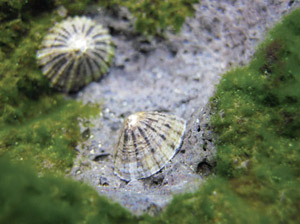The Birds, The Bees And ‘Opihi
Here’s something to chew on.The next time you find yourself at a family luau enjoying that precious tiny portion of ‘opihi, think about this: Which ones are males and which one are females?
Chances are you’ve probably never asked the question, but if you love ‘opihi, maybe you should.
The salty morsels may taste the same, but there is a difference. Scientists have found that the edible limpets start off as males, but as they age, many often change to females. They also know that females discharge their eggs and males discharge their sperm into the sea. Those eggs are carried by the currents and are fertilized in the ocean. The larvae hatch, join other plankton and feed on microscopic algae, and later settle and become miniature adults.
It’s our responsibility not to pick them too early – but that doesn’t always happen. For the record, ‘opihi must have a shell diameter of at least one and one-fourth inches in order to be harvested, and the diameter of the foot must be at least half an inch. Unfortunately, the lack of compliance, combined with over-harvesting, have resulted in what seems to be a never-ending ‘opihi shortage.
Researchers are trying to learn more about the spawning behavior of ‘opihi in hope of improving proper management and restoration. An interdisciplinary team of western and Native Hawaiian researchers recently returned from a trip to the Papahanaumokuakea Marine National Monument, where they studied the ‘opihi’s fragile reproduction process.
The team consisted of participants from Texas A&M University, the Scripps Institute of Oceanography, The Nature Conservancy, Na Maka o Papahanaumokuakea, Conversation International-Hawaii Fish Trust, Kaho’olawe Island Reserve Commission, Kalapana Fishing Council, Na Mamo o Muole’a and Kipahulu ‘Ohana.
This is the fourth consecutive research and monitoring activities at Nihoa Island, Mokumanamana Island and French Frigate Shoals in the Northwestern Hawaiian Islands. It’s all part of a five-year partnership among scientists, cultural researchers and community members.
Their latest trip yielded an interesting find.
“We have preliminary evidence that female ‘opihi live higher on the rocky shore than male ‘opihi,” says Dr. Chris Bird, a scientist from Texas A&M University. “This is a groundbreaking discovery that will contribute toward better understanding of ‘opihi reproduction, which will help marine managers when considering restoration of ‘opihi habitat in populated areas like Oahu.”
Hoku Johnson, NOAA’s coordinator of the expedition, believes the new information on this “iconic food species” will help manage fisheries across the archipelago.
“The research in the monument is connected to similar research being done in partnership in the main Hawaiian Islands, which we hope will lead to better management of ‘opihi statewide,” says Johnson.
Besides discovering that female ‘opihi live higher on the rocks than males, researchers also found that ‘opihi in the Northwestern Hawaiian Islands are bigger when they reach reproductive readiness than those in the main Hawaiian Islands. Scientists believe this indicates that overharvesting in Hawaii may be forcing our ‘opihi to reproduce before they are truly ready. The result is smaller ‘opihi.
It’s too early to say if this latest discovery will be the catalyst to drastic changes to our ‘opihi harvesting rules and requirements, but anything is possible.
So will ‘opihi pickers think twice about gathering large ‘opihi living higher on rocks? Probably not, but it’s obvious something needs to change.
Nature is already doing its part trying to keep up with demand. We need to do our part as well. If we don’t, one day at the family luau we could be without.
It’s certainly something to chew on.




